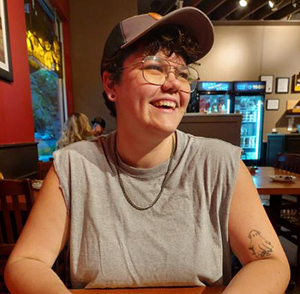Returning to the Body:
Hannah Eiserman interviews
Janine Alyson Young

Volunteer Hannah Eiserman talks with Janine Alyson Young, whose story "We Age and Age, but She's Vivid" appears in our winter issue #225. They discuss writing during the heaviest time of the pandemic, confronting our own biases when it comes to mental health and addiction, and rejecting expectations of our roles and identities.
Read an excerpt from "We Age and Age, But She's Vivid" here.
Janine Alyson Young is a writer and editor from the West Coast of BC. Her short story collection Hideout Hotel (Caitlin Press 2014) was shortlisted for the Danuta Gleed Award, and her work has been published in Event Magazine and the anthology Boobs. She has an MFA in Creative Writing from the University of British Columbia, and a BFA from the University of Victoria. For the last decade, she worked as a freelance editor, and she is now the managing editor at Nightwood Editions, an indie press proud to publish some of country’s finest writers. Janine is humbly slogging through the final draft of her first novel. She lives with her husband and kids on the traditional land of the Skwxwú7mesh People (Sunshine Coast, BC). https://www.janinealysonyoung.com/
Photo credit: Kelly Schuster
Since I’m always interested in process, I would love to start by asking where this story began for you? How did these characters, and their dynamic, emerge into being?
I wrote an early draft of this story during the heaviest time of the pandemic, when people were isolated, and our awareness of each other’s suffering was collectively heightened and every vulnerability was accentuated. In BC the overdose rate was especially high. I was making extra effort to connect with my friends who lived alone and who had already been struggling with their mental health and addiction. A lot of the story is about that dangerous edge of ourselves, but it’s also about pleasure and recklessly ceasing what we want or need—through these characters I was interested in exploring the inner chaos that many of us were experiencing in those days.
This story is quite fixated on place and distance. Several specific locations are named, like Mount Royal and of course, the part of the story happening in present time takes place at Nadine’s family’s home. Zoe recalls the way she, Sal, and Nadine weaved in and out of each other’s lives as they aged. The story ends with her saying she and Sal “drift near each other.” Would you speak on what place and distance, physical and metaphorical, means for these characters, and for friendship overall?
Setting is crucial to me as a writer. I’m sensitive and I find my surroundings strongly affect me and that always seems to be true for my characters too. In this story, the details of the hometown, both past and present—the remoteness of the island, the smoky skies, the way the ocean is both potentially dangerous and a source of pleasure, the way both Zoe and Sal consider seeking refuge in the forest at different times—reflect aspects of their inner selves. I wanted these characters to reconnect in this potent landscape because it forces their past and present to blend, as well as their inner and outer selves to surface.
Secrecy and hidden selves are a big part of this story. Each of the friends—Zoe, Nadine, and Sal—have sides of themselves that are mysterious and stigmatized. Zoe is fixated on laying eyes on Sal, on watching Sal; she wishes Nadine were alive so that she, too, could simply look at Sal. For Zoe, there is no substitute for physical proximity and physical witness. This is mostly because of Sal’s struggle with addiction; there’s subtext in the story that suggests Sal’s addiction has made her secretive and evasive. So, for practical reasons, physical distance is a barrier to the kind of friendship Zoe wants with Sal—but throughout their reunion, Zoe starts to understand that the way she loves Sal and shows up for Sal has to evolve. Zoe is almost trying to capture Sal, but in the process, Zoe discovers her own ignorance. She realizes that her own personality or life experience is a barrier itself in understanding Sal, and the best she can do in the moment is exist with Sal. It’s through a shared physical experience that they have a surprising moment of connection.
Moving from that assertion on the importance of place: being relatively new to BC, I had to look into Riverview, “that infamous hospital,” as Zoe calls it. I found an article published by CTV Vancouver this year which said “By the 1980s, the hospital was actively being downsized for two reasons: a belief patients belonged in community rather than warehoused and out of sight, and the government deciding it was financially better as well.”
Nadine would have been at Riverview around 2010, when closure was ramping up, and around the time of her suicide. With close friendship being at the heart of this story, does your story suggest that community has a role in mental health care? Or should I say a responsibility?
This is a hard question to answer. I think in some ways, the story is circling the opposite suggestion—that without proper healthcare and education, we as community can feel helpless and ill-equipped to support each other. Riverview is briefly referenced in the story; to me, with my limited experience, the institution has always been a notorious symbol of trauma and failure. Around 2010, in the era of closure, vulnerable people were ousted without continuity of quality health care. Like Zoe, I lost a good friend to suicide after her stay in Riverview. She was absolutely loved and adored by her community; she really was the best of all of us. But all the love in the world wasn’t a substitution for the right medication and professional care. I don’t know of many communities that are equipped to handle complex mental health needs without well-trained and compassionate professionals and fully accessible resources—especially if their loved ones are emerging traumatized, stigmatized, and disconnected from society. But I think, I hope, that’s changing. If we do have a responsibility, it’s in advocating for proper care and confronting our own biases that contribute to stigmatization.
A line that really struck me was: “This is part of the compulsive negotiation I keep with myself—pursuing habits that are bad for me but mitigating the risks. I’d rather walk around with smouldering embers pressed against my body, crackling in my own grasp.” The story negotiates between self-destruction and pleasure found in near-danger. This moment is one for Zoe. At the end, she believes Sal is about to harm herself, but then realizes she is actually having a deeply pleasurable and profound experience. Do you feel that your story suggests these two things are often found in the same act? How do the characters negotiate with the distinction?
Age plays a big part in this story. Zoe and Sal are in their late thirties. I’m pushing forty myself, and I have found it’s an era of life when we’re given the chance to really understand who we are. We’ve been through enough cycles and patterns to realize what’s a passing phase and what’s a part of us to celebrate or change. It can be a time of life, too, where we realize that to be true to ourselves and to really take responsibility for ourselves, we might need to reject expectations of our roles and identities. I think that process can sometimes involve some self-destruction; both women are engaging with some form of self-destruction but in very different ways and for different reasons.
I was really interested in exploring characters at this age and at this point in their lives. They’ve both simultaneously realized that pleasure is a matter of survival. Pleasure, the kind of pleasure that disconnects them from all failure and expectation and instead connects them to their bodies and souls, is kind of radical for these two. The world is literally burning around them, but pleasure is still there for the taking and it’s like a big deep breath. I don’t think these two characters have the answer to the distinction yet—but returning to the body in a profound way is a beginning.
What did you read in 2023 that really excited you? Did anything influence your writing?
I’ve had a funny year of reading. I’ve been reading specific upmarket fiction and bestsellers to see what all the fuss is about. I’ve been doing this because as a literary novelist I want to better understand how to write active plot and tension. Although I devoured some, I didn’t enjoy most. I admit I kind of hate-read them. For a balm, I read some (luckily also successful) boldly bizarre books like Sheila Heti’s Pure Colour and plot-light books like Ocean Vuong’s On Earth We’re Briefly Gorgeous and Lisa Hsiao Chen’s Activities of Daily Living. As both a writer and a managing editor of an indie press, I think about the balance of artistic expression and viability. I don’t read to be entertained, I read to deepen my understanding of the world and my own humanness, no matter how nuanced or seemingly microscopic the view. Reading unusual and risky books is soothing and rebellious in this capitalistic world—but publishing is competitive, so I’m interested in finding a balance. (Shout out to all the publishers taking a chance on the weird and beautiful books.)
And can you tease the novel you’re working on right now? What kind of themes and ideas are you exploring?
I’ve been painstakingly teaching myself how to write a novel through trial and error, which has been a long and humbling process. The novel I’m wrapping up now is called Young Thing. It follows a young woman caught in a love triangle which sets her on a ten-year search to understand love—how to love herself and others, and what she deserves. The book spans from her late teens into young motherhood, and explores themes of bisexuality, lust, self-destruction, motherhood, the body, and forgiveness. I wanted to write something that flays the impossible balancing act of womanhood—a portrait of a young woman on an uncompromising search for her humanness.
I’m also dipping into my next novel, which is about three generations of family on a remote island as their community faces relocation due to climate change.

Hannah Eiserman









